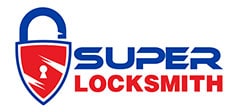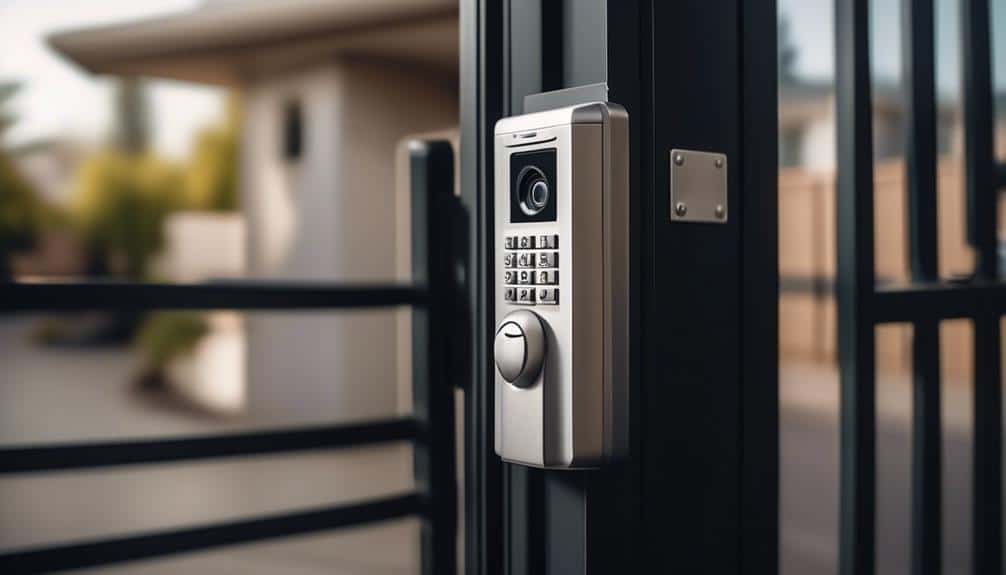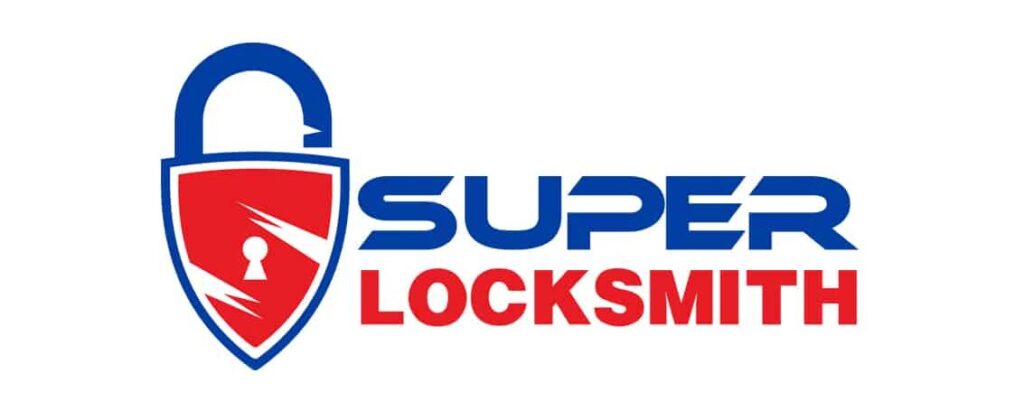When it comes to property management, ensuring maximum access control is crucial for maintaining the security and integrity of the premises. However, there are often overlooked tips and strategies that can significantly improve access control measures.
In this discussion, we will explore ten expert recommendations that property management companies may not be aware of, but can greatly enhance their access control systems.
From key management best practices to integrating cutting-edge technology, these tips will empower property managers to safeguard their properties effectively.
So, let's dive in and discover how to maximize access control for property management companies.
Master Key System Basics
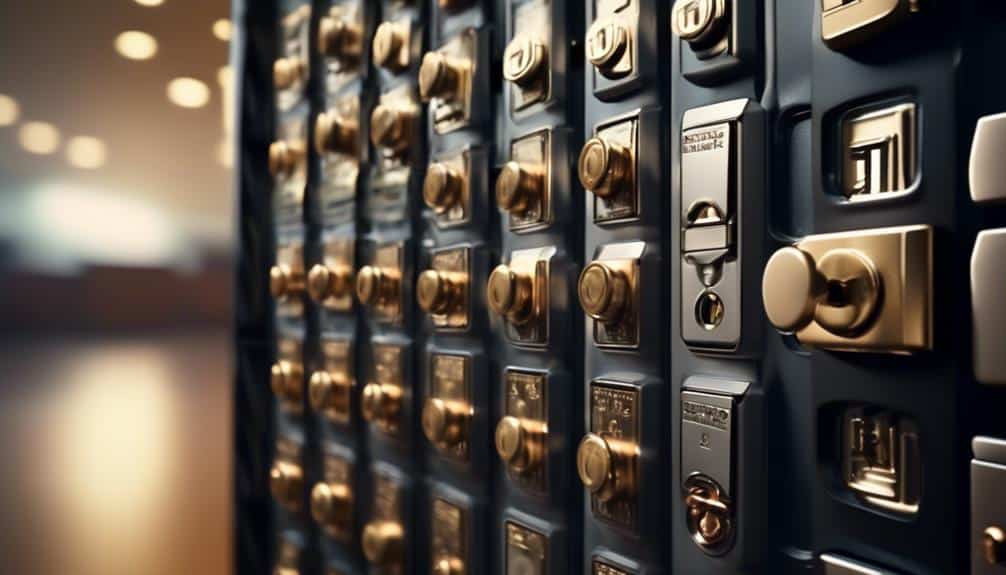
In order to enhance the efficiency and security of access control systems, property management companies often employ the use of master key systems. These systems allow for the creation of a hierarchical structure, where different individuals or groups have access to specific areas within a property.
However, it's crucial for property management companies to prioritize master key system maintenance and security to ensure optimal functionality.
Regular maintenance is essential for the smooth operation of a master key system. This includes inspecting and lubricating locks, replacing worn-out keys or cylinders, and updating access levels as needed. By conducting routine maintenance, property management companies can prevent issues such as key breakage or malfunctioning locks, which could compromise the security of the system.
Security is a paramount consideration when it comes to master key systems. It's crucial to have strict control over the distribution and duplication of master keys. Limiting access to authorized personnel and keeping a record of key holders helps to minimize the risk of unauthorized key duplication or misuse. Additionally, incorporating advanced security features such as restricted keyways or electronic locks can further enhance the security of the system.
Key Management Best Practices

When it comes to managing keys, property management companies need to focus on three key aspects:
- Efficient key distribution ensures that keys are issued to the right individuals in a timely manner, minimizing the risk of unauthorized access.
- Secure key storage is crucial to prevent theft or loss of keys, which could compromise the security of the property.
- Regular key audits help ensure that all keys are accounted for and that any missing or unaccounted for keys are immediately addressed.
Efficient Key Distribution
To ensure efficient key distribution, property management companies should implement key management best practices. Efficient key tracking is essential for maintaining control over access to properties. By utilizing automated key distribution systems, property management companies can streamline the process and reduce the risk of lost or misplaced keys.
These systems allow for easy tracking of keys, ensuring that they're properly accounted for and can be quickly located when needed. Automated key distribution also eliminates the need for manual record-keeping, reducing the chances of human error and improving overall efficiency. Additionally, these systems can provide real-time updates on key usage, allowing property managers to monitor who's access to specific properties at any given time.
Implementing automated key distribution is a crucial step in maximizing access control for property management companies.
Secure Key Storage
With efficient key distribution in place, property management companies can now focus on implementing secure key storage practices to further enhance their access control systems.
Secure key management is crucial for ensuring the protection of property and the safety of residents. To achieve this, property management companies should establish rigorous key control procedures.
This includes using secure key cabinets or lockboxes that are resistant to tampering and unauthorized access. Key cabinets should be located in secured areas, such as a locked office or a designated key room, with limited access granted only to authorized personnel.
Additionally, keys should be labeled with unique identifiers and stored in a systematic manner to facilitate efficient tracking and retrieval. Regular audits and inspections should also be conducted to ensure the integrity of the key storage system.
Regular Key Audits
Regular key audits are an essential practice in key management, ensuring accountability and maintaining the integrity of the access control system. Key audit frequency and process play a crucial role in identifying any potential security gaps and addressing them promptly.
The frequency of key audits should be determined based on the risk level associated with the property and the number of keys in circulation. For high-security properties, conducting key audits on a monthly or quarterly basis is recommended.
During the key audit process, property management companies must physically inspect and account for each key to ensure they're in the right hands and that no unauthorized copies exist.
Additionally, documenting key audit findings and following up on any discrepancies is vital to maintain a strong access control system.
Assessing Access Control Needs

As property management professionals, we must carefully evaluate and analyze the specific access control needs of our properties. Assessing access control systems and evaluating security measures are crucial steps in ensuring the safety and security of our properties and their occupants.
When assessing access control needs, it's important to consider the unique characteristics of each property. This includes factors such as the size and layout of the property, the number of entrances and exits, and the types of tenants or occupants. Conducting a thorough evaluation allows us to identify potential vulnerabilities and determine the appropriate level of access control required.
One key aspect of assessing access control needs is identifying the types of threats that the property may face. This could include unauthorized entry, theft, vandalism, or even potential acts of terrorism. Understanding these potential threats helps us in selecting the right access control systems and security measures to mitigate these risks.
Another important consideration is the level of access control required for different areas within the property. For example, high-security areas such as server rooms or sensitive storage areas may require stricter access control measures compared to common areas or parking lots. By categorizing areas based on their security needs, we can effectively allocate resources and implement appropriate access control measures.
Identifying Keyholders and Permissions
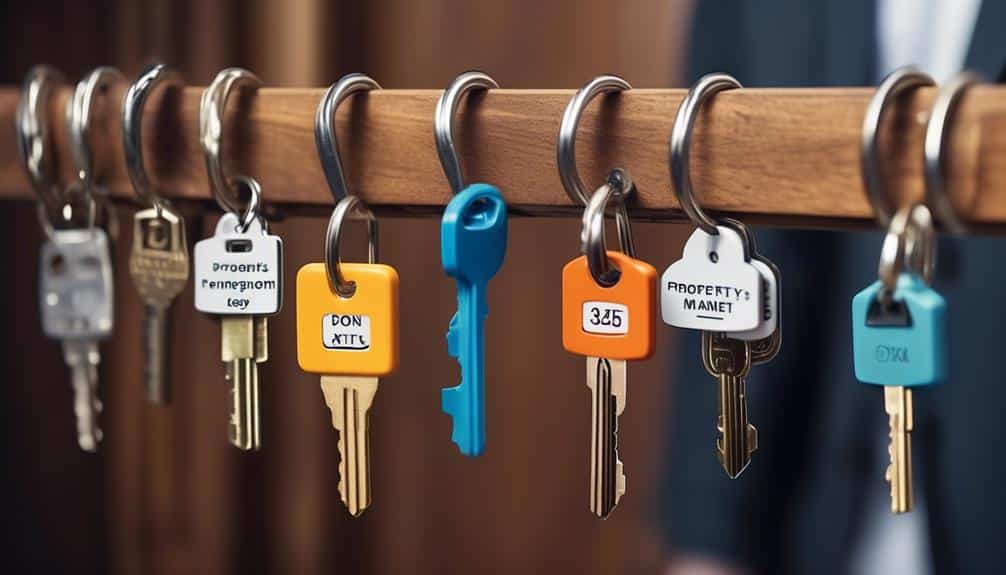
When it comes to access control, it's crucial for property management companies to identify keyholders and establish their permissions.
Authorized personnel should be clearly defined to ensure that only the right individuals have access to different areas of the property.
Managing access permissions is also important to prevent unauthorized entry and maintain security.
To achieve this, a thorough keyholder identification process should be implemented, including verifying credentials and regularly updating access rights.
Authorized Personnel and Access
To effectively manage authorized personnel and access, property management companies must accurately identify keyholders and their corresponding permissions. This involves implementing robust systems for authorized personnel screening and utilizing the latest access control technology advancements.
Authorized personnel screening is crucial in ensuring only trustworthy individuals are granted access to the property. Property management companies should conduct thorough background checks, verifying the identities and credentials of potential keyholders. This can include checking criminal records, employment history, and references.
Access control technology advancements have greatly improved the efficiency and security of managing authorized personnel and access. From keycards and biometric systems to cloud-based access control solutions, property management companies now have a wide range of options to choose from. These technologies not only provide enhanced security but also allow for easier administration and tracking of keyholders' access permissions.
Managing Access Permissions
We can identify keyholders and their corresponding permissions by implementing a comprehensive system for managing access permissions. This system should include managing access levels and utilizing access control software.
Managing access levels allows us to categorize keyholders based on their roles and responsibilities within the property management company. This categorization helps us determine the appropriate level of access each keyholder should have.
Access control software plays a crucial role in this process as it enables us to create and modify access permissions quickly and efficiently. It also allows us to track and monitor keyholder activities, ensuring that access is granted only to authorized individuals.
Keyholder Identification Process
Implementing a comprehensive keyholder identification process is essential for effectively managing access permissions in property management companies. This process involves identifying keyholders and assigning appropriate permissions based on their roles and responsibilities.
To ensure a smooth and secure keyholder authorization process, property management companies should consider the following:
- Conduct thorough background checks: Before granting keyholder access, it's crucial to verify the identity and background of individuals to establish trust and reduce potential risks.
- Implement a clear permission hierarchy: Establishing a well-defined permission structure helps ensure that keyholders have access only to the areas they need for their specific tasks.
- Regularly review and update keyholder permissions: As roles and responsibilities change, it's necessary to review and update keyholder permissions accordingly to maintain optimal access control.
- Enforce keyholder accountability measures: Implementing measures such as access logs, surveillance systems, and periodic audits can help hold keyholders accountable and deter unauthorized access.
Implementing Key Control Policies
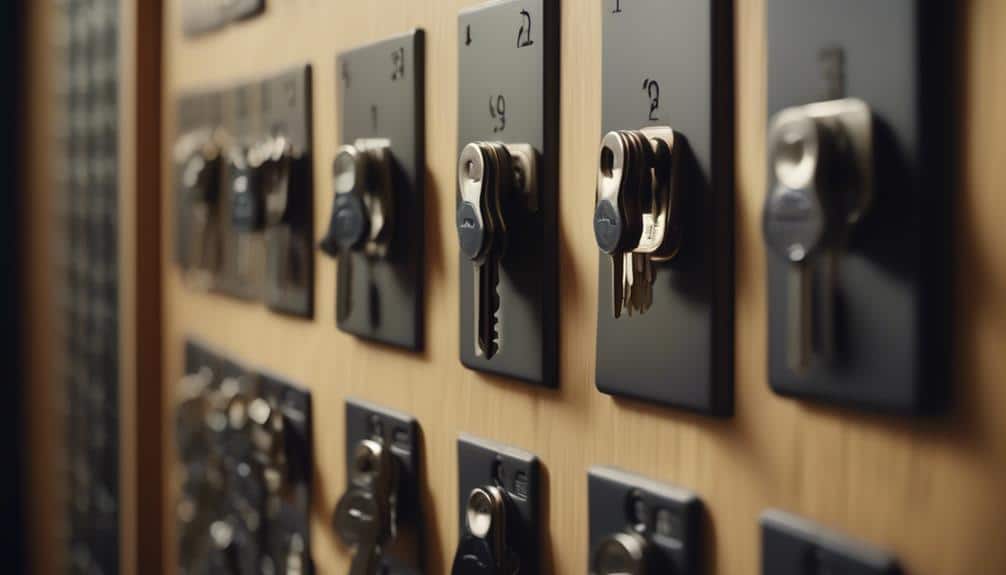
Using an effective key control policy is crucial for property management companies to maintain security and prevent unauthorized access. Implementing key control policies ensures that keys are properly tracked and accounted for, reducing the risk of theft or misuse. This can be achieved through the use of key control software and key tracking systems, which provide real-time visibility and control over key access.
To implement an effective key control policy, property management companies should consider the following tips:
| Tip | Description |
|---|---|
| 1 | Establish a clear chain of custody for keys, documenting every instance of key issuance and return. |
| 2 | Limit access to keys by assigning them only to authorized personnel and implementing a strict key sign-out process. |
| 3 | Regularly audit key inventory to ensure all keys are accounted for and identify any discrepancies. |
| 4 | Implement a secure key storage system, such as a locked cabinet or key management system, to prevent unauthorized access to keys. |
Regular Key Audits and Maintenance
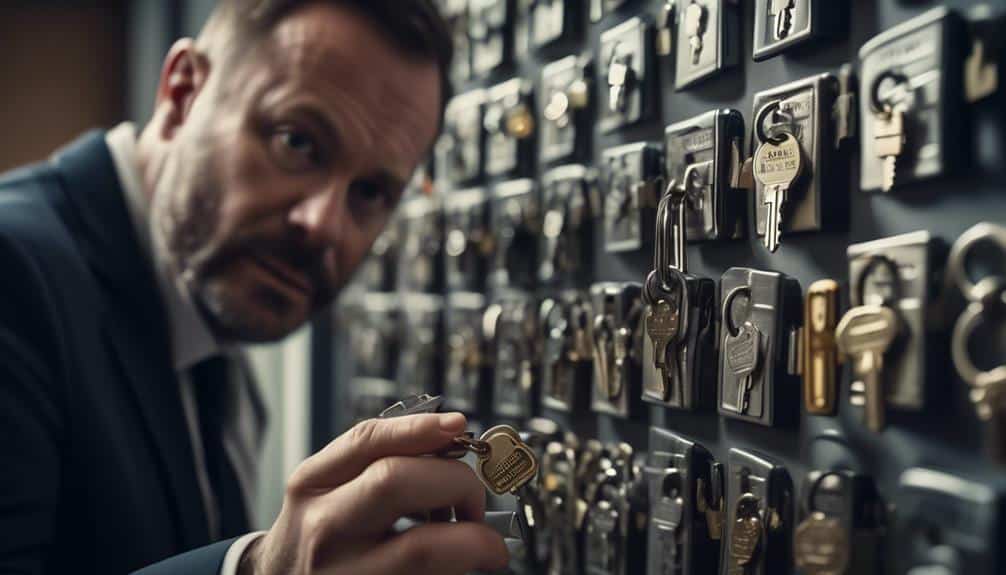
Now let's talk about the importance of regular key audits and maintenance in property management.
Key inventory management is crucial to ensure that all keys are properly accounted for and that unauthorized copies aren't floating around.
Regular maintenance checks should be conducted to ensure that all keys are functioning properly and any issues are addressed promptly.
Additionally, auditing access logs allows property management companies to track key usage and identify any potential security breaches.
Key Inventory Management
Regular key audits and maintenance play a crucial role in ensuring effective key inventory management for property management companies. It's important to have a system in place that allows for regular audits and maintenance of keys to avoid any security breaches or loss of access.
Here are four key strategies for successful key inventory management:
- Utilize key tracking software or key management software to keep a digital record of all keys and their respective holders.
- Conduct regular physical audits of key inventory to ensure that all keys are accounted for and in the proper hands.
- Implement a system for reporting lost or stolen keys immediately, so that necessary actions can be taken to mitigate any security risks.
- Schedule regular maintenance checks on key storage systems, such as key cabinets or lockers, to ensure they're functioning properly and securely.
Regular Maintenance Checks
To ensure the effectiveness of key inventory management, property management companies must regularly conduct maintenance checks to safeguard against security breaches or loss of access. These checks involve performing key audits and maintaining a regular maintenance schedule to ensure that all keys are accounted for and in proper working condition. Property inspections are an essential part of these maintenance checks, as they allow property management companies to identify any issues with the access control system and address them promptly. By conducting regular maintenance checks, property management companies can minimize the risk of unauthorized access and ensure that all keys are functioning correctly. The table below provides an overview of the key components of a maintenance schedule for property management companies.
| Maintenance Task | Frequency | Responsible Party |
|---|---|---|
| Key audits | Quarterly | Property Manager |
| Key maintenance checks | Monthly | Maintenance Staff |
| Property inspections | Biannually | Property Manager |
| Access control system review | Annually | Security Team |
Auditing Access Logs
As part of the ongoing maintenance and security measures, property management companies regularly conduct key audits and maintenance checks to ensure the integrity of their access control systems. Auditing access logs is a crucial aspect of this process, allowing companies to monitor and analyze access activity for potential security breaches or unauthorized entries.
To effectively audit access logs, property management companies should consider the following:
- Regularly reviewing access logs to identify any suspicious or abnormal activity.
- Analyzing access patterns to detect any inconsistencies or anomalies.
- Ensuring that access control software is capable of generating detailed and comprehensive access logs.
- Conducting periodic evaluations of access control software to ensure it meets the company's auditing and security requirements.
Enhancing Security With Keyless Entry
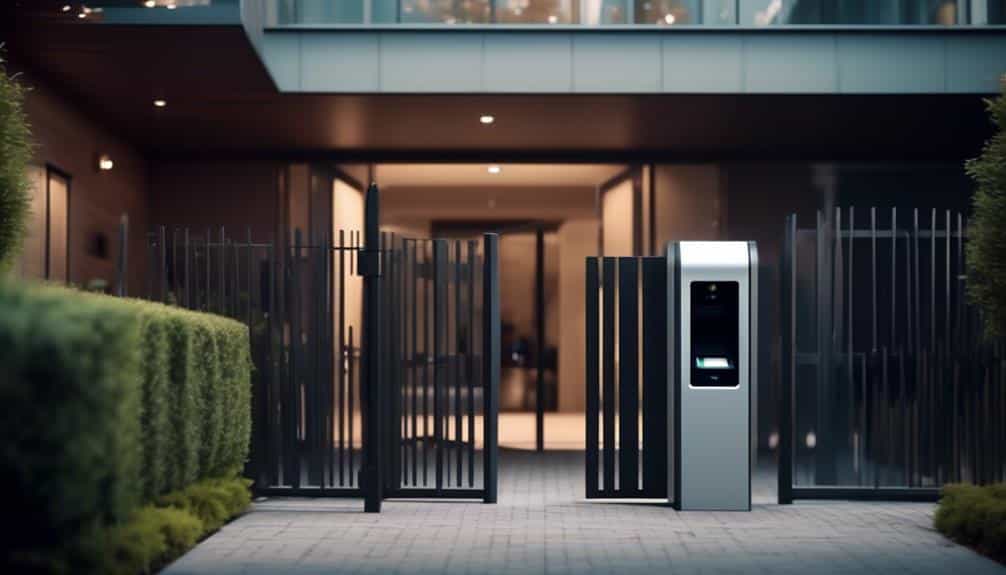
We can enhance security by implementing keyless entry systems, which provide an efficient and secure alternative to traditional lock and key mechanisms. Keyless entry benefits include improved access control, increased convenience, and enhanced security. With keyless entry, property management companies can easily manage and monitor access to their buildings, ensuring that only authorized individuals can enter.
Keyless entry installation involves the deployment of electronic or wireless locks that can be accessed through various means, such as key cards, key fobs, or biometric authentication. These systems eliminate the need for physical keys, which can be lost or stolen, and allow for easy access control management.
Here is a table highlighting the advantages of keyless entry systems:
| Keyless Entry Benefits | Description |
|---|---|
| Improved Access Control | Keyless entry systems provide greater control over who can enter the building. |
| Increased Convenience | Users can easily gain access without the need for physical keys. |
| Enhanced Security | Keyless entry systems offer advanced security features, such as biometric authentication. |
Training Staff on Access Control Procedures

Our staff training program focuses on equipping employees with the necessary knowledge and skills to effectively implement and enforce access control procedures. We understand the importance of training effectiveness in ensuring that our staff fully understands their roles and responsibilities in maintaining a secure environment.
Here are four key elements of our training program that contribute to its effectiveness and staff accountability:
- Comprehensive Curriculum: Our training curriculum covers all aspects of access control procedures, including the use of keyless entry systems, monitoring access logs, and responding to security incidents. By providing a comprehensive understanding of these procedures, we ensure that our staff is well-prepared to handle any situation that may arise.
- Practical Hands-on Training: We believe in the power of experiential learning. Our staff undergoes practical training sessions where they can apply their knowledge in real-world scenarios. This hands-on approach helps them develop the necessary skills and confidence to effectively implement access control procedures.
- Regular Refresher Courses: Access control procedures are constantly evolving, and it's essential that our staff stays up-to-date with the latest practices. We conduct regular refresher courses to reinforce their knowledge and ensure that they're aware of any updates or changes in the procedures.
- Ongoing Performance Monitoring: To maintain staff accountability, we implement a system of ongoing performance monitoring. This includes regular audits of access control logs, assessing staff compliance with procedures, and providing feedback and support when needed. By continuously monitoring staff performance, we can identify areas for improvement and take corrective actions as necessary.
Integrating Access Control Systems
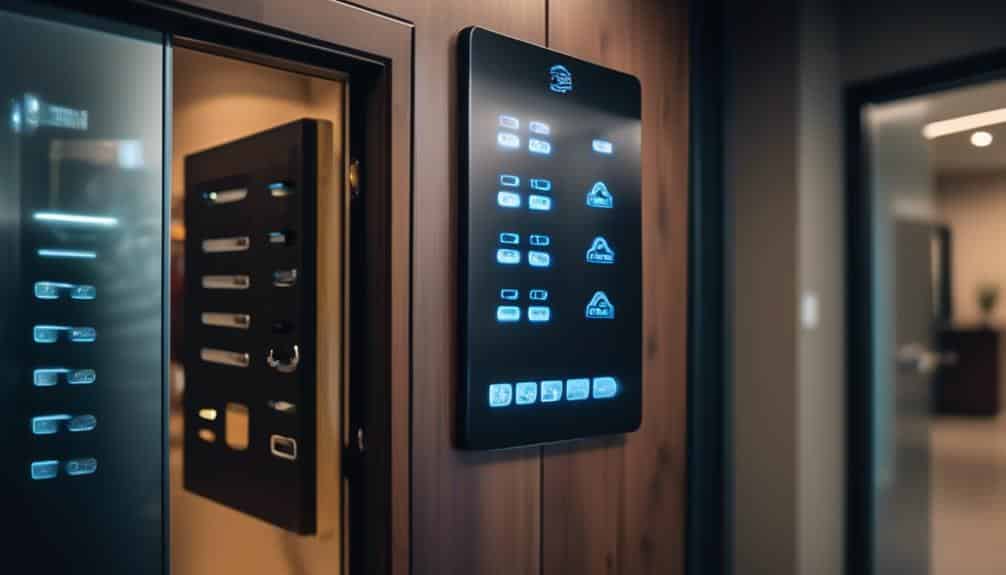
Integrating access control systems requires careful planning and coordination to ensure seamless functionality and enhanced security measures. When integrating access control technology into your property management company, it's essential to consider several key factors.
First, assess your current infrastructure and determine if any upgrades or modifications are needed to support the new system. This may involve installing additional wiring or network infrastructure.
Second, select a reputable access control provider that offers comprehensive solutions and technical support. They should be able to assist with troubleshooting access control systems and provide ongoing maintenance and updates.
Third, establish clear communication channels between your property management team and the access control provider to ensure a smooth integration process. Regular meetings and progress reports can help address any issues or concerns promptly.
Finally, consider conducting thorough training sessions for your staff to familiarize them with the new system and its functionalities.
Monitoring and Updating Access Control Measures
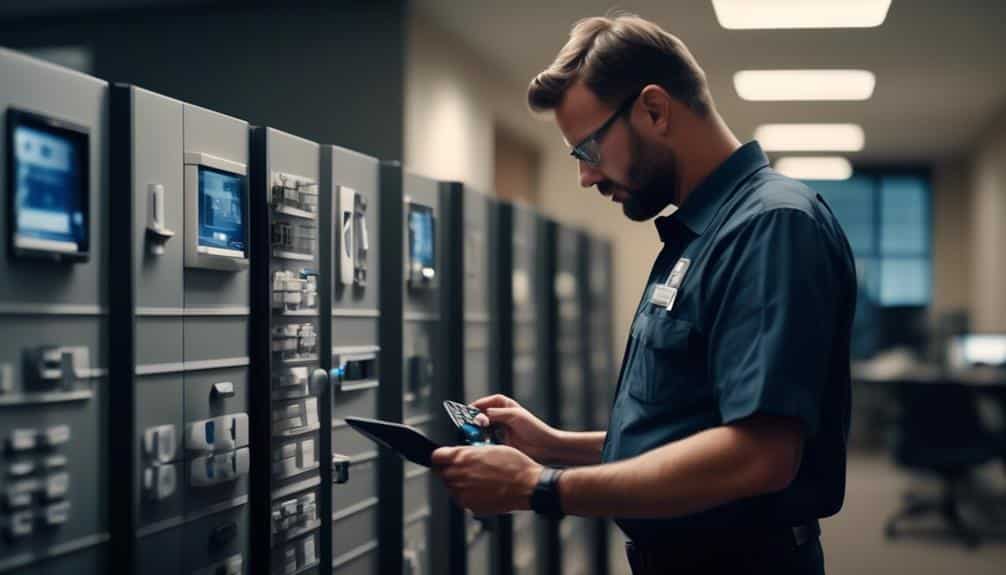
To ensure effective access control measures, property management companies must actively monitor and regularly update their systems. This ongoing process is crucial for maintaining the security of the premises and ensuring that access control measures are functioning as intended.
Here are some key considerations when it comes to monitoring and updating access control measures:
- Regularly updating access control software: Technology evolves rapidly, and it's essential to keep access control software up to date. Regular updates help address any vulnerabilities and ensure that the system is equipped with the latest security features.
- Conducting access control system troubleshooting: Proactively identifying and resolving any issues with the access control system is vital for its smooth operation. Regular troubleshooting allows property management companies to address any glitches or malfunctions promptly.
- Monitoring access control logs: Monitoring access control logs allows property management companies to track who's accessed the property and when. By regularly reviewing these logs, any suspicious or unauthorized activities can be detected and addressed promptly.
- Implementing an audit trail: An audit trail is a record of all access control system activities. By implementing an audit trail, property management companies can keep track of system changes, user activity, and any attempts to tamper with the system.
Frequently Asked Questions
How Can Property Management Companies Ensure the Security and Confidentiality of Their Master Key Systems?
To ensure the security and confidentiality of our master key systems, we follow best practices for access control and master key management. We prioritize the use of secure key management systems and restrict access to authorized personnel only.
Regular audits and maintenance of our key systems are conducted to identify and mitigate any potential security risks. Additionally, we train our staff on proper key handling procedures and enforce strict protocols to prevent unauthorized duplication or use of master keys.
Is It Possible to Track and Monitor Keyholders' Access Activities?
Yes, it's possible to track and monitor keyholders' access activities.
By implementing a comprehensive access control system, property management companies can ensure keyholder accountability and enhance security.
With features like electronic key fobs or cards, access logs can be generated to record each keyholder's entry and exit times.
This allows for real-time monitoring and auditing of access activities, helping to identify any unauthorized or suspicious behavior.
Tracking access activities is crucial for maintaining the security and confidentiality of master key systems.
What Steps Should Property Management Companies Take to Prevent Unauthorized Key Duplication?
Preventing key duplication is vital in maintaining security. To ensure the utmost protection, property management companies must implement best practices for key management.
By carefully controlling key distribution and regularly auditing keyholders, unauthorized duplication can be minimized.
Additionally, utilizing advanced key systems that incorporate restricted keyways and patented key blanks can further enhance security measures.
Are There Any Specific Legal Regulations or Requirements That Property Management Companies Need to Consider When Implementing Access Control Measures?
When implementing access control measures, property management companies need to consider specific legal requirements and compliance considerations. These regulations vary depending on the location and jurisdiction.
It's essential to research and understand local laws regarding access control, such as privacy laws, data protection regulations, and building safety codes.
Compliance with these regulations ensures that property management companies are operating within the legal framework and protecting the rights and safety of tenants and residents.
How Can Property Management Companies Effectively Communicate Access Control Policies and Procedures to Their Tenants and Employees?
Effective communication strategies are crucial for property management companies to ensure tenants and employees understand access control policies and procedures. By utilizing clear and concise language, we can provide step-by-step instructions and guidelines.
Regular employee training sessions can reinforce awareness and emphasize the importance of following security protocols.
Additionally, implementing a digital platform or portal can centralize communication and provide easy access to relevant information. This ensures everyone is on the same page and promotes a safe and secure environment for all.
